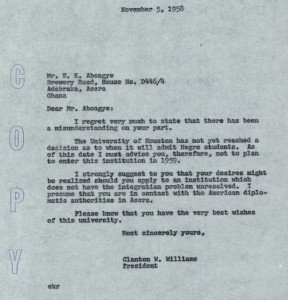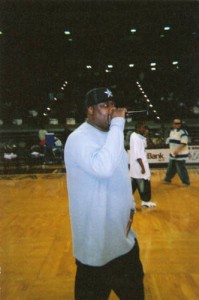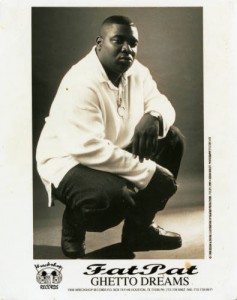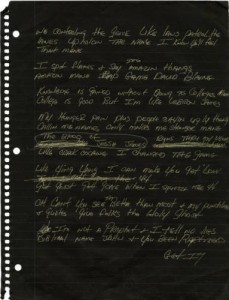
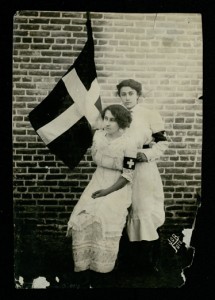
Leonor Villegas de Magnón and Aracelito Garcia with flag of La Cruz Blanca (Leonor Villegas de Magnón Papers, 1914)
Another on the list of recently published digital collections–Photographs from the Leonor Villegas de Magnón Papers.
Previously, we have written about the larger Leonor Villegas de Magnón Papers and how pleased we are that our partnership with Arte Público has made available for study the papers of such a trailblazing, radical Latina. The recent publication of this digital collection, featuring select photographs, will provide prospective researchers a new window into a figure much obscured from our predominant Texana narrative.
Born in Nuevo Laredo, Mexico in 1876, Leonor Villegas de Magnón would lead a life that, for a woman of her time, place, and disposition, found her pushing headlong into a fierce, at times unfriendly current of history in the American Southwest. Educated in San Antonio and Austin, Texas, Magnón would take up permanent residence in Laredo and is remembered today as an educator, journalist, activist, and the founder of La Cruz Blanca (The White Cross) during the Mexican Revolution in 1913 (following in the tradition of other voluntary relief organizations being established to nurse the wounded of war). Her remarkable life is documented in her autobiography, La Rebelde (the Lady Rebel).
Included in this new digital collection are portraits, landscapes, and photographs showcasing her work in the Mexican Revolution as well as candid photographs featuring her family and friends. Notable figures like Porfirio Díaz, Jovita Idar, and Pancho Villa, can be found throughout the collection.
We hope you enjoy this new digital collection of photographs and invite you to visit the Special Collections Reading Room should you wish to further explore the Leonor Villegas de Magnón Papers.
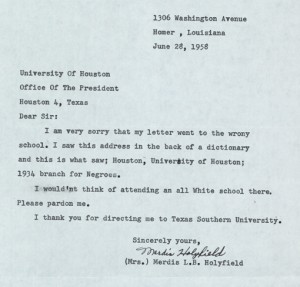
“I would’nt think of attending an all White school there. Please pardon me.” (detail of a letter from Merdis L.B. Holyfield to UH President, 1958, from the University of Houston Integration Records)
A number of new digital collections have been rolling out over at our Digital Library and if you blink, it’s been tough to keep up. Over the coming days we will publish some highlights, showcasing these new and exciting primary sources now made available to researchers, free from the constraints of reading room hours or the patron’s locale.
One collection new and of note? Check out the University of Houston Integration Records.
The University of Houston is rightly proud of its gender and ethnic diversity. Often touted as one of the most ethnically diverse research universities in the nation, Cougars come in all colors and creeds. The integration of the University’s athletics programs under coaches Guy V. Lewis and Bill Yeoman changed the face of collegiate athletics in the South and is thoroughly documented in Katherine Lopez’s Cougars of Any Color. The image of Lynn Eusan’s beaming smile in 1968, as she became the first black homecoming queen at a predominantly white university in the South, still looms large in our history and marked another step in UH’s legacy of integrated and equal.
However, this diversity and legacy did not happen by accident or overnight.
The University of Houston Integration Records document the early days of hand-wringing and tiptoeing around an issue that still confounded so much of the nation and, unresolved, threatened to tear communities apart. While violent opposition to integration plumbed new depths for history, particularly throughout the South, what resulted at UH were steady, incremental, and quiet steps, spearheaded by University Presidents Clanton C. Williams, A.D. Bruce, and Phillip G. Hoffman. Working with community leaders, University Administration would eventually oversee an admissions process that resulted in twenty black students being enrolled at UH in the spring of 1963.
By 1964, football and basketball illustrated the importance of intercollegiate athletics, as Elvin Hayes and Don Chaney were dominating the hardwood for Coach Guy V. Lewis and Warren McVea was gearing up to revolutionize the game in Coach Yeoman’s veer offense (all while enduring merciless and ugly epithets from fans of programs in the Deep South). The nation had been put on notice. A university, in the South and striving to become colorblind, was not only surviving but thriving by serving all the sons and daughters of Houston, and ultimately scholars the world over. In doing so, they have left us an inheritance of a virtual global village doing remarkable work on Cullen Boulevard.
Included in these University of Houston Integration Records are documents from the 1940s through the 1960s, with an emphasis on the ’50s and ’60s. Correspondence and internal memoranda from University Administration, as well as documents and letters related to the applications of prospective black students (both domestic and international) highlight the poignancy of the collection. The sheer absurdity of segregation laws and practices in the United States hits home as one reads President Williams’ flailing attempt in 1958 at an explanation to a Ghanaian student regarding the particulars of his denial of admission:
“I regret very much to state that there has been a misunderstanding on your part.” (detail of letter from UH President Clanton W. Williams to prospective student, E.K. Aboagye, 1958, from the University of Houston Integration Records)
I regret very much to state that there has been a misunderstanding on your part.
The University of Houston has not yet reached a decision as to when it will admit Negro students. As of this date I must advise you, therefore, not to plan to enter this institution in 1959.
I strongly suggest to you that your desires might be realized should you apply to an institution which does not have the integration problem unresolved. I presume that you are in contact with the American diplomatic authorities in Accra.
Needless to say, the University of Houston has come a long way since then, now embracing its diversity as a core value and strength.
Selections in the University of Houston Integration Records are pulled from the President’s Office Records in our University Archives. Original documents may be viewed in the Special Collections Reading Room during our normal research hours or on the Digital Library at your leisure.
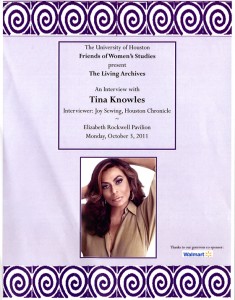
Living Archives promotional material from the UH Women’s Studies Program and Friends Collection
New and varied content continues to be published via the Digital Library on a regular basis. Thanks to these efforts, researchers unable to visit the Special Collections Reading Room in person benefit from remote access to critical primary resources. Last week some new additions went live and Vince Lee, Archivist for the Carey C. Shuart Women’s Archive and Research Collection, provides us with the details below.
Who knew that oral histories could be so much fun and attract such a star-studded lineup? The University of Houston Special Collections is pleased to announce six new additions to the Barbara Karkabi Living Archives Series. You’ll meet Houston women who impacted the environmental movement, allowing us to enjoy Houston’s green spaces, women who had a hand in designing the architecture you see all around you, and women whose dishes you may have savored in the culinary world. If that wasn’t enough, watch an interview with Joanne King Herring as she recounts her role in charities and assisting Afghan resistance fighters (as depicted by Julia Roberts in Charlie Wilson’s War). Or, if pop culture grabs your interest, Tina Knowles talks about her early life and career in establishing her brand in the fashion industry (yes that “Knowles,” the mother of Beyoncé–who attended the original interview recording, by the way, and drew huge crowds on campus). Finally, we have our very own President Khator as she recounts her own personal life and journey which took her from India, to the United States, to ultimately being confirmed as the President and Chancellor of the University of Houston.
Visit the Barbara Karkabi Living Archives Series or Carey C. Shuart Women’s Archive and Research Collection for more information.
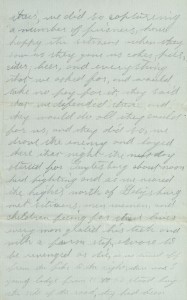
“… as we neared the heights north of Gettysburg met civilians, men, women, and children fleeing for their lives, every man grated his teeth and… swore to be revenged or die…” (detail from William W. Edgerton’s Gettysburg diaries)
The hits just keep on coming over at the University of Houston Digital Library with last week’s publication of the Civil War Letters digital collection.
With the flurry of additional items added to existing collections along with new collections going live over at the Digital Library, you may have just missed some of the new ground being broken for military historians or those with perhaps just a passing interest in Civil War history.
Combined from the M.L. Calk Civil War Letters, the W.D. Lowther Civil War Letters, and the earliest accessioned collection in our Military History collections, the William W. Edgerton Civil War Letters, this digital collection pulls together multiple sources providing researchers with a new view of these artifacts as well as new tools to answer that gnawing question of, “Where?”
When the location of a letter’s origin is known, a new map component accompanying this collection allows us to identify visually where the letter was written. We think Civil War buffs will appreciate this new functionality and the potential for future researchers, in this collection or those to come, is immediate and sure to be invaluable for those whose research interests are pinned to particular regions or desire to visually explore artifacts by locale.
Included among these digital items are letters belonging to both Confederate soldiers (Calk and Lowther) as well as correspondence from the Union side of the conflict (Edgerton). Quiet moments of correspondence cutting through the cacophony of warfare have long been prized by researchers as rich veins of information and insight. The correspondence of these brothers in arms is no different, offering personal views throughout.
Examples include bits like Lowther relating to his fiance, Phronie, the ordeal of a six day march or Edgerton’s writings allowing us a look into his diaries from the Battle of Gettysburg. M.L. Calk on the other hand, who served with the 23rd Alabama Volunteer Infantry Regiment, writes home to his mother from Vicksburg, Mississippi in February 1863 as he attempts to ease her mind, assuring her that he does not think he will have to fight, certain there will be “peace before long,” as the Yankees are “laying their army down and [swear] they won’t fight any longer for Lincoln. They have white men under Negro Colonels, and they say they can’t stand that…”
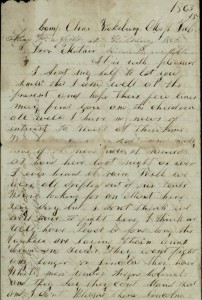
“… I don’t think we will have to fight here. I think we will have peace before long…” (from M.L. Calk’s letter home, prior to the Siege of Vicksburg)
Later, Calk would write to his sister, as the noose of General Ulysses S. Grant’s siege of Vicksburg tightened in May, that he “saw many fall and heard many crys and groans of the dying and wounded,” but counts his blessings as “the Lord was good and merciful… even a ball did not touch [his] clothes though they were flying as thick as hail all around… and many fell on every side.” Following the Union’s victory at Vicksburg, along with Robert E. Lee’s defeat at Gettysburg, Calk mustered out in July 1863. A map on the collection’s homepage, peppered with various colored dots from the Midwest, through the Tennessee Valley, stretching both north and south, illustrates the far-reaching impact of a war that threatened to permanently tear a nation asunder.
Spend some time exploring this new, rich, and interactive collection. But, if the digital collection has simply served as an apéritif, we invite you to come experience these original materials in the Special Collections Reading Room.
The breadth and depth of resources in the the Houston Hip Hop collections continue to grow with today’s announcement that the HAWK Photographs and Memorabilia are now available for patrons’ virtual perusal at the University of Houston Digital Library.
HAWK, or John Edward Hawkins, was born and raised in Houston and, along with his older brother Patrick Lamark Hawkins (Fat Pat), was an integral component of the Screwed Up Click (a group of Houston area rappers centered around the pioneering production work of DJ Screw). HAWK, Fat Pat, DJ Screw, and their friend Kay-K would go on to create the collaboration Dead End Alliance (D.E.A.). Before Fat Pat could realize the success of his debut album Ghetto Dreams, he was shot to death in 1998 at the age of 27 and the album was released posthumously.
HAWK’s solo debut, Under H.A.W.K.’s Wings, was released by Dead End in 2000, followed by his sophomore release HAWK. However, after marrying longtime girlfriend Meshah Henderson in April 2006, John Edward Hawkins’ life was also tragically cut short when he was shot to death on May 1, 2006 at the age of 36. Endangered Species, released following his death, would help continue the musical legacy of the S.U.C., D.E.A., and the Hawkins brothers.
Here at the University of Houston Special Collections we are proud to preserve that legacy and make the HAWK Papers available for study to scholars interested in Houston hip hop. The addition of these materials to the Digital Library, combined with the previous DJ Screw Photographs and Memorabilia and Pen & Pixel highlights, has us excited about the increased online access to a burgeoning field of research. Among the highlights in this new Digital Library collection are publicity photographs, candid snapshots, as well as a personal favorite of mine, a notebook belonging to HAWK replete with his lyrics handwritten in gold ink on black pages.
Please enjoy these new items available for study in the Digital Library and come see us when you are ready to study all of these, and more, in the Special Collections Reading Room.
